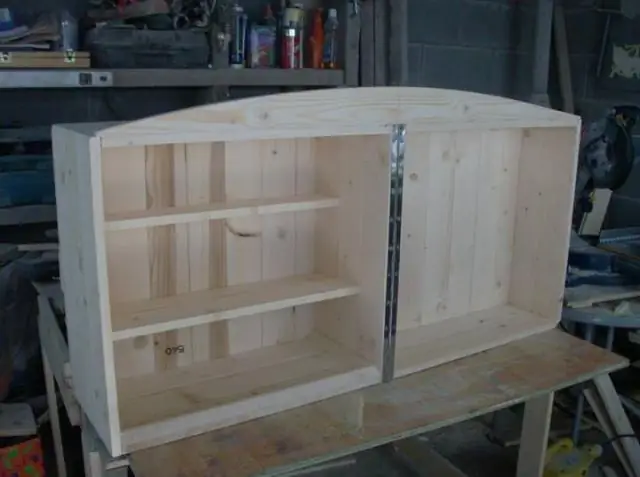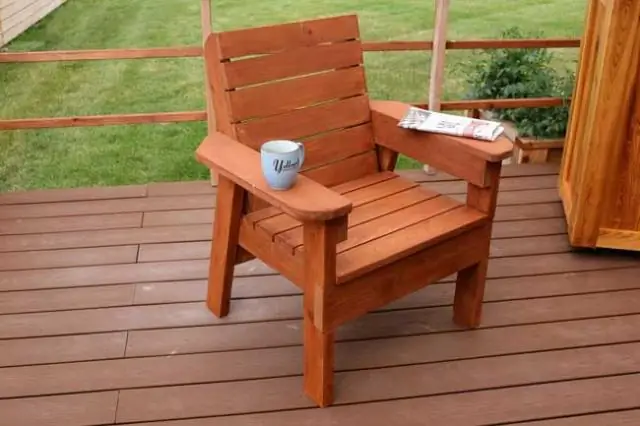
Table of contents:
- Different models of do-it-yourself hanging chairs
- What kind of hanging chairs can be made by hand
- Materials and techniques for making home chairs
- Step-by-step instructions for making a hanging swing chair
- Drawings and diagrams for a cocoon structure
- How to make a crocheted nest chair
- Making a seat using macrame technique
- Suspended mounting options
- Author Bailey Albertson [email protected].
- Public 2024-01-17 22:26.
- Last modified 2025-06-01 07:32.
Different models of do-it-yourself hanging chairs

In an effort to comfortably equip a living space, many people prefer non-standard design solutions. They are able to bring originality to the familiar interior and provide additional comfort. These items include DIY hanging chairs.
Content
-
1 What kind of hanging chairs can be made by hand
- 1.1 Hanging swing
- 1.2 Wicker cocoon
- 1.3 Chair-nest from a hoop
-
2 Materials and techniques for making home chairs
2.1 DIY hanging chairs - gallery
-
3 Step-by-step instructions for making a hanging swing chair
3.1 How to make a hanging hammock yourself from a hoop and fabric - video
-
4 Drawings and diagrams for a cocoon structure
4.1 Simple twig weaving techniques - gallery
- 5 How to make a nest chair with a knitted bottom
-
6 Making a seat using macrame technique
6.1 Hanging hammock chair using macrame technique - video
- 7 Suspension mounting options
What kind of hanging chairs can be made by hand
Among the variety of hanging chairs, there are models that you can make yourself. Such options will become a highlight of your interior. In addition, self-fabrication allows you to realize an individual concept, which is based on proven and reliable designs.
Hanging swing
Unusual swing chairs are made from various materials. A feature of such structures is their elegance, simplicity and the ability to use both rigid and soft frames. These chairs can become a stylish decoration of a country house, an unusual addition to the interior of a bedroom, living room, children's room or veranda.

Hanging swing chair can be made by yourself
Wicker cocoon
No less popular is the cocoon chair or the egg chair. A feature of the model is the presence of walls that hide the internal space by about 2/3. These chairs allow you to enjoy privacy, they are most popular among children due to the external resemblance to a hanging house, suitable for games. Cocoons are usually made from natural materials for weaving.

A cocoon chair is made from weaving materials
Nest chair made of hoop
The most popular homemade model is a nest chair made on the basis of a hoop frame. Such a model can be equipped with many decorative elements, and its shape harmoniously fits into the living space of modern apartments. Various weaving techniques are used to make the nest chair.

The nest chair is easy to make yourself using a hoop and thick threads
Materials and techniques for making home chairs
When choosing the materials necessary for the manufacture of hanging chairs, first of all consider the features of the model of interest.
- For a swing chair, dense textiles, synthetic ropes of various types and wooden bars are suitable.
- A cocoon chair is made of rattan, willow twigs, bast, rakita or bird cherry, which have the necessary flexibility.
- To make a nest chair, plastic or steel hoops are needed to ensure the rigidity of the structure. And also you cannot do without wear-resistant textiles, synthetic fillers, decorative braiding cords and wooden blocks of different sizes.

To make it, you will need flexible rods or rattan.
Craftsmen use a variety of techniques to create hanging chair seats:
- macrame. Artistic interweaving of rope and rope knots gives the chairs an airiness, ensuring a flawless appearance;
- patchwork. To ensure the strength of the seat, the patchwork is sewn over the dense wear-resistant material;
- knitting. The combination of durable cords of various colors allows you to implement unusual design solutions;
- tatting. Thanks to their delicacy, these designs look weightless, instantly attracting attention to themselves.

The tatting hanging chair feels weightless
Remember that the materials selected must be suitable for specific weights. A fabric that is too thin or laced can tear under the weight of a large person. The fastening elements also deserve special attention and strength testing: chains, ropes, braids, on which the structure is suspended.
Hanging chairs made by hand - gallery
-

Swing chair made of fabric - Suspended swing chair made of fabric - a convenient addition to a country house
-

Cocoon armchair - A cocoon chair made of dense fabric will appeal to children
-

Hanging rattan chair - The rattan cocoon hanging chair is strong and durable
-

Hanging Nest Chair - Hanging nest chair made of dense fabric is suitable for relaxing in a summer cottage
-

Swing chair - A simple model of a swing chair is easy to make with your own hands
-

Hanging swing chair made of wood and dense fabric - The original hand-made hanging chair will become a source of pride for the owners
-

Macrame hanging chair - Suspended swing chair, woven using macrame technique, adds coziness and comfort
-

Wicker hanging chair - The openwork seat for the hanging chair can be woven from a thick cord
-

Suspended bassinet chair - The hanging chairs can be used as a bassinet for an infant
Step-by-step instructions for making a hanging swing chair
The swing chair can rightfully be called one of the simplest models that you can do yourself. To create it, you will need:
- 2 meters of dense fabric (canvas, satin, trouser fabric);
- a wooden stick about 1 m long and 5-6 cm in diameter;
- drill and twist drill (15-20 mm);
- carbines (11 cm) with a carrying capacity of 160 kg;
- rope for static belay 10-11.5 mm thick with breaking load from 2600 to 3200 kgf;
- sewing machine, scissors, ruler.
- paint, brushes, iron and strong synthetic fibers.

Necessary tools for making a hanging swing chair
Having prepared everything you need, you can start making an unusual interior detail.
- Fold the selected fabric in half, then count 18 cm from the top corner.
- Carefully cut the resulting triangle (photo 1).
-
Sew on all sides of the fabric cut, while bending the edges by 1.5 cm (photo 2).

Cutting material Cut the material and hem the edges
- Form the rope pockets (Photo 3). On the long side of the workpiece, fold the edges 4 cm and sew them with a sewing machine (photos 4 and 5).
-
Make two holes on both sides of the wooden stick at a distance of 5 cm from each other, while the distance between the pairs of these holes should be about 80 cm (photo 6).

Forming the corners of the textile blank and processing the wooden stick Form and sew the corners required to secure the cables
- Insert a rope into the holes located closer to the center of the stick and fix it with knots. At the same time, in the center of the cable, also tie a knot necessary for attaching the carabiner.
-
Pass the sections of the rope hanging under the stick through the fabric blank, and insert its ends into the free holes located closer to the edges of the stick. Secure them with a secure knot (photo 8).

Fixing the cables Fix the ropes on a wooden stick
-
Attach two carabiners connected to each other to the hook previously fixed to the ceiling. This will ensure that you can swing safely in the chair. Thread the cable into the lower karabiner.

A cable threaded into a carbine For the cable, choose a thick cord that can support the weight of an adult
The resulting suspended swing chair can be additionally equipped with soft pillows for comfort.
How to make a hanging hammock yourself from a hoop and fabric - video
Drawings and diagrams for a cocoon structure
To manufacture the original model of the hanging chair you will need:
- rods of rattan or willow with a diameter of 10 or 15 mm, approximately 450 pieces;
- a ready-made metal hoop, metal pipes or several thick branches of a vine, woven together in the form of a circle;
- strong rope and glue, which will be needed to tie the frame;
- knife, ruler, pruner and awl;
- a nylon cord with a cross section of 4 mm, used for weaving the back (it can also be made from a vine);
- ropes, chains or cords for hanging the finished structure from the ceiling.
Beginners will need a ready-made cocoon scheme, which allows them to correctly calculate the dimensions of the future chair.

Use the chart to accurately calculate the length and width of the product
When manufacturing, follow the instructions.
-
Chop the vine, peel and steam, then beat thoroughly. These manipulations will give her the flexibility she needs for weaving.

Weaving vine The vine needs to be cleaned, steamed and beaten off to give flexibility
-
Then start forming the frame of the future chair. It can be made from metal pipes or a slightly flattened hoop, if the final shape of the product should be oval. In the case of using a pipe, connect its ends using inserts.

Metal hoop connection Connect the parts of the hoop using metal inserts
- Connect all the remaining elements to the pipe, which acts as a frame base, one by one. If the seat is to be mounted vertically, use rods 6-8 mm thick, the length of which should exceed the height of the seat by 250-400 mm.
- Attach each of the rods to the upper parts of the frame so that a gradual expansion is maintained between them. In the middle of the backrest, the distance should be 20 - 25 mm.
- Bending the rods, give the future chair depth and shape. Make sure that they are reassembled at the bottom of the structure.
- When using horizontal rods in the process of creating a frame, fasten them to the sides of the workpiece. Install them at a distance of 20-25 mm from each other, then give them the desired shape.
- To secure the vine, gently bend it through the pipe from the inside of the chair to the outside. Fix the ends with a rope.
-
Interlace the finished structure with thinner rods, moving from bottom to top.

Thin vine for weaving The basis for a hanging chair is created using weaving from a thin vine
- If it is necessary to braid the frame from horizontally fixed rods, start the work from the middle of the back in both directions. Bend the end of the rod that is on the pipe and twist it around the base.
- Press each new layer of thin twigs as hard as possible against the previous one.
- Braid the entire basket. Bend the end of the last rod, tuck in and securely fasten in the main weave.
You can braid the frame in different ways. For beginners, simple techniques can be used to provide a firm seating base.
Simple twig weaving techniques - gallery
-

The simplest weaving technique - Even beginners can cope with such weaving.
-

Vine weaving patterns - Various weaving patterns can be used to make hanging rocking chairs
-

Weaving options from flexible rods - Using weaving from twigs, you can create a dense base for the chair
How to make a crocheted nest chair
To create a nest chair that will become an exquisite decoration for an apartment or garden, you need to prepare the following materials:
- metal hoop with a diameter of 90 to 110 cm, with a cross section of at least 35 mm;
- 700-800 m of polyester cord with a diameter of 4.5-5 mm;
- crochet hook No. 8-9;
- slings - 12 meters;
- roulette;
- scissors.
Wrap the hoop taken as a basis with a strong twine, fixing every tenth turn with a knot, this will not allow the cord to unravel.

Winding the hoop with a cord and securing it
You can use a variety of crochet techniques to create the bottom. To make such a seat, you need 120 to 160 m of cord. The exact amount depends on the selected knitting pattern.
- Start from the center. Tie a circle as tight as possible using single crochets and chain stitches.
-
Begin the formation of the seat with 6-7 circles, then move on to the back in the form of a knitted mesh.

Making a seat for a knitted hanging chair Start knitting a seat from a cord from the center, gradually forming the back of the future chair
-
Pull the finished napkin over the hoop, evenly distributing it over the entire base. The resulting structure should not sag. Attach to the hoop from the tight knit side, without cutting the cord.

Fastening a finished napkin from a cord The knitted seat for the hanging chair should not sag to the sides
-
Attach slings to the finished product.

Fastening a hanging chair-nest with a knitted seat The fastening must be strong and reliable, the safety of the finished product depends on it
Making a seat using macrame technique
For this type of hanging chair, you will need:
- 7 strands, 6 m each;
- 4 threads, 5 m each;
- 4 strands of 4.5 m;
- 2 strands of 4 m;
- 2 metal hoops with a diameter of 90 and 110 cm.
Having prepared the cords of the required length, proceed to attaching them to the hoop.
- Starting from the center, fasten 7 long strands in pairs, 6 cm apart.
-
Continue fastening the threads along the sides of the warp. As a result, on one side there should be 2 strands of 5 m, 2 strands of 4.5 m and 1 strand of 4 m in length.

Attaching the cords to the hoop Attach the long and short cords in pairs on the base
-
Then start weaving the pattern from the center of the workpiece.

The beginning of weaving the pattern Weaving the pattern should start from the center
-
As a result of the work, you should get an openwork circle.

Ready circle Finished openwork circle - the basis for a seat using macrame technique
- Secure each strand with a flat knot to prevent the rope from slipping in a circle.
- When knitting, always observe the tension, placing the knots at intervals of 6 cm.
Additionally equip the resulting structure with reliable slings and a soft cushion.

A swing chair, made on the basis of the macrame weaving technique, must be additionally equipped with a pillow
Hanging hammock chair using macrame technique - video
Suspended mounting options
The hanging chair can be attached in different ways. One option is a ceiling hook. The finished product suspended in this way can swing in different directions, but moving it to another part of the room is very problematic.

Installation of a ceiling hook is only possible with a high-quality concrete floor, which guarantees a secure attachment
Equally popular is the rack mount, which can be purchased from specialized stores. This design is equipped with circular platforms for stability. The armchair on the counter can be easily moved around the apartment and even taken out into the street.

Metal posts for hanging chairs provide stability and mobility of the structure
Another option is axial fastening, which allows the structure to be fixed between the ceiling and the floor. This method is suitable for decorating children's rooms.
If the ceiling in your house is not reliable and hollow enough, you can install the hanging chair using a chemical anchor. This method involves the introduction of polymer paste into the ceiling cavity from a syringe, after which the product is installed.

Installation of a hanging chair with an anchor is necessary if the ceilings in the house have voids
In the process of hardening, it is possible to achieve a strong and reliable fixation, while the minimum bearing capacity of the chemical anchor is 200 kg.
Simple options for making a hanging chair at home are available even to novice craftsmen. Unusual designs decorate the interior, give the room originality and comfort. Good luck with your work and create with pleasure!
Recommended:
How To Make A Polycarbonate Gazebo With Your Own Hands - A Step-by-step Guide With Step-by-step Photos, Drawings And Videos

In the construction of any structure, incl. do-it-yourself polycarbonate gazebos, have their own nuances. Our article will introduce you how to make such a structure
How To Make Cages For Quails With Your Own Hands: Drawings And Step-by-step Instructions + Photos And Videos

How to create reliable and practical quail cages from different materials with your own hands. Schemes and drawings with detailed descriptions. Video tips and tricks
How To Make Garden Benches With Your Own Hands From Pallets, Pallets And Other Materials At Hand - Step By Step Instructions With Photos, Videos And Drawings

Do-it-yourself construction of classy garden benches from pallets, old chairs and other improvised materials: step-by-step instructions, drawings, photos, videos
How To Make A Rocking Chair (including Plywood) With Your Own Hands: Types, Step-by-step Instructions, Drawings, Etc. + Photos And Videos

How to make a rocking chair with your own hands. Different types of chairs, materials, step-by-step instructions for making simple models
How To Make A Slate Fence With Your Own Hands - Step By Step Instructions, Construction Options And Decorations With Photos And Videos

How to choose the right slate for your fence. How to make measurements and calculations. DIY step-by-step instructions for installing a slate fence
